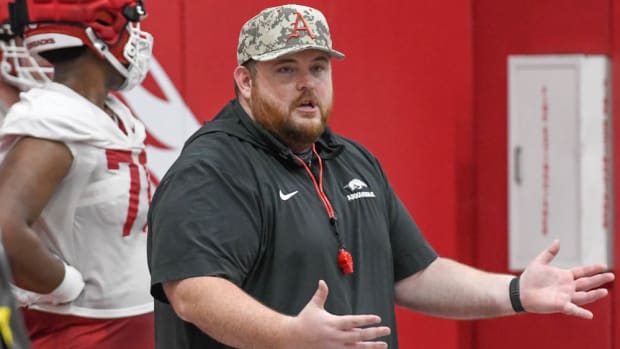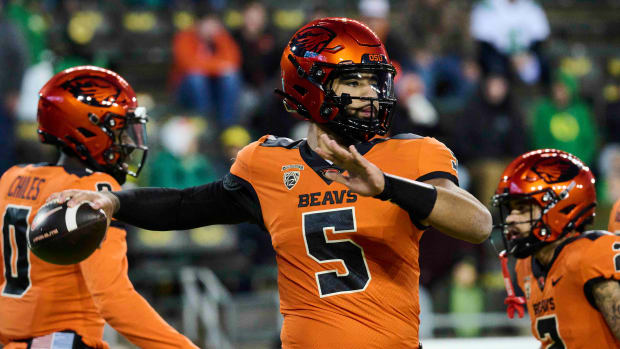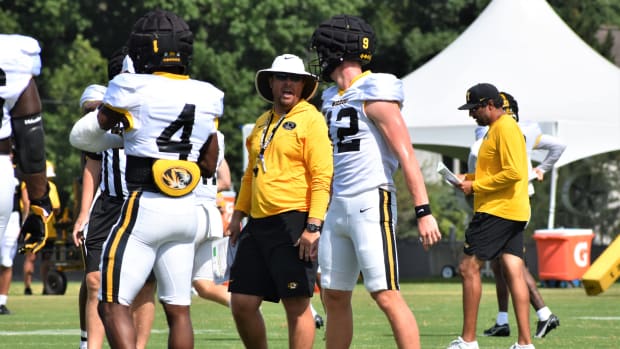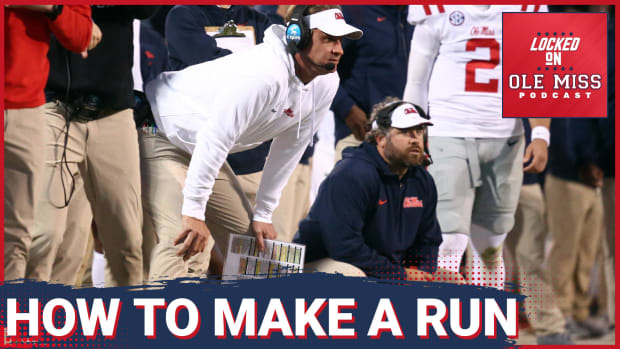Exhausted and Exasperated, College Football Officials Still Unable to Agree on Playoff Model
INDIANAPOLIS, Ind. — Years ago, about 500 miles west of here in Kansas City, an NCAA executive committee made up of school presidents, shot down a playoff expansion proposal that sent one man angrily storming out of the room.
“I’ve got better things to do than this!” Charles Young, the UCLA president and the chairman of the 1994 NCAA committee exploring expansion, famously shouted at the presidents following the vote.
Nearly 30 years later, college football has witnessed another swing-and-miss and more angry storm-outs. College Football Playoff officials could not agree on expansion during a meeting Monday blocks away from the site of tonight’s national title game at Lucas Oil Stadium.
The result from CFP leaders delays expansion of the four-team postseason, leaving many frustrated, exhausted and, like Young, angry.
Big 12 commissioner Bob Bowlsby, visibly and audibly disappointed while speaking to reporters, bemoaned a process that has ended with only a plan to meet more. Meanwhile, SEC commissioner Greg Sankey suggested that his league–more dominant over the last two decades than any other–has no incentive to continue negotiating, though he says he will, for now.
“Those who asked (to expand the playoff) are not ready to act,” Sankey said to a small group of reporters after emerging from meetings Monday in downtown Indianapolis. “It’s in my best interest to leave it at four.”
While expected, the latest failed attempt at expansion is costly in more ways than one. For now, officials are passing on both $450 million in additional revenue and 16 extra playoff spots that a 12-team playoff would have generated in 2024 and 2025. In order to break the CFP’s contract with ESPN—it runs through the 2025 season—CFP officials need unanimity. They don’t have it.
At least two and maybe three commissioners opposed the recommended model that the CFP Management Committee presented Monday to the Board of Managers, which is the CFP’s executive board including representation from the 10 FBS conferences and Notre Dame.
For those involved in the negotiations and others across the country, the decision is vexing. They are searching for underlying reasons why a minority of leaders are resistant to approve an expansion model supported by at least eight of the 11 commissioners.
“There’s more parochiality than there needs to be,” Bowlsby said. “I’ve spent the last three days (of meetings) reading the cards on the table. You’ll have to ask them (why they’re against it).”
Those opposing the expansion proposal are “entrenched” in their beliefs, Bowlsby said. The commissioners are “no closer,” he said, to having certain issues resolved than when they arrived here for meetings starting Friday.
At an event in Las Vegas last month, Big Ten commissioner Kevin Warren and ACC commissioner Jim Phillips publicly expressed their opposition for the first time in this six-month stretch of deliberations. They believe in automatic qualifiers for Power 5 champions, they told an audience of administrators at the Aria Resort & Casino. Furthermore, Phillips says the process should be delayed until after the on-going NCAA transformation is complete, and he also holds the belief that eight teams, not 12, is the appropriate amount for a playoff.
Nine committee members have publicly supported the original 12-team playoff model. The proposed model grants automatic bids to the six highest-ranked conference champions, gives first-round byes to the highest ranked four champions and completes the field with six at-large selections. The first round would be played on campus before a rotation of six bowls is used for the quarterfinals and semifinals.
At the request of the presidents, a subcommittee of three commissioners and Notre Dame AD Jack Swarbrick created the proposal after two years of deliberations in secret. They released the plan to the public in June before it was formally presented to the full Management Committee in person, a move that Alliance members—the Pac-12, ACC and Big Ten—have chided.
“I think it was received favorably,” said Bowlsby. “Since then, we’ve spent time on it. Some don’t like it now. … We knew it was going to get out and so we went ahead and shared the details of it. It wasn’t intended to bind anybody.”
Sankey and many others are baffled by an obvious truth: The conferences that need expansion the most and strongly encouraged it three years ago are the ones either on the fence or flatly voting against the current proposal.
“We don’t need this,” Sankey said on expansion, a wave of his arm.
The SEC has qualified at least one team in 15 of the last 16 title bouts, has won 12 of those and has sent 18 teams to the last 16 championship games. In fact, a few blocks from the site of Monday’s meetings, two SEC teams, Georgia and Alabama, meet for the championship—the third time in 11 years that’s happened.
The SEC’s dominance has been such in the CFP and BCS eras that Sankey joked, in speaking about automatic bids, that maybe his league should get two.
This year, three of the five power conferences were not represented in the playoff— the second time that’s happened in the CFP’s eight years. The Pac-12 hasn’t advanced to the playoff since 2016.
“In December 2018, conference leaders from those not in the SEC were loudly and publicly calling for expansion. We were not,” Sankey said. “It’s not good for college football to have an entire region not central to the (playoff) conversation—the West.”
The stalemate has dragged on long enough—six months—that officials are barreling toward an arbitrary deadline. The hope of expanding in the final two years of the CFP contract with ESPN, in 2024 and 2025, is at a near unattainable point, commissioners say. As each day passes, expansion’s earliest year moves closer to 2026, the first year of what would be the CFP’s new multi-media rights deal.
CFP executive director Bill Hancock described the situation as “going into overtime,” but did not rule out expansion before the contract ends, though a decision is needed “soon.”
Says Sankey: “This may be a nine-overtime game where nobody can score a two-point conversation right now. But that doesn't mean you stop.”
Sankey says the SEC’s willingness to take part in expansion talks and to support an expansion model is an “enormous give” for a conference that doesn’t need it. He strongly suggested that the SEC might not be as willing to take part in future negotiations. His presidential representation hinted at the same.
CFP Board of Managers Chairman Mark Keenum, president of Mississippi State, left open the possibility of maintaining a four-team playoff even after the current contract ends “if these issues aren’t resolved,” he said.
“Do we have an expansion or do we keep the status quo?” he asked. “The status quo has worked pretty well for the Southeastern Conference.”
Would the SEC really take its proverbial ball and go home? The league’s power only continues to grow. Its success on the field has generated a mega new TV deal with ESPN, so significant that it helped lure away the Big 12 Oklahoma and Texas, which are set to join the league in 2025.
In one of its most transformative times, the landscape of college sports is beginning to shift. That might impact future playoff negotiations if they continue to drag on, suggested Sankey, who himself is leading an NCAA transformation committee that could bring change to the Division I structure.
“If we have to stop and go to Square 1, we all have to understand, it’s not as if things stay as they are,” he said.
Meanwhile, the Pac-12 and the Big Ten have a historic relationship to consider. The two leagues hold a lucrative separate contract with the Rose Bowl, the oldest bowl game in college football. The expansion proposal impacts that agreement, the date of the game’s kickoff and the traditional matchup of teams, something seen as a possible hurdle to expansion.
The Pac-12 released a statement detailing how the league is open to any of the six formats that have seriously been discussed.
Automatic qualifiers, another sticking point, are built into the 12-team proposal, but they are not designated to specific conferences. Phillips and Warren have spoken in favor of Power 5 champions earning an automatic berth—something of which Bowlsby, Sankey and several Group of 5 commissioners have been publicly critical.
Over the last six months, leaders have explored multiple formats, including an eight-team model, but none have garnered what is necessary to break the contract early—unanimity. Sankey is against any eight-team format with six automatic bids, as it limits the at-large selections to only two teams. Group of 5 commissioners are against an all-at large eight-team model because it does not provide them yearly access.
“There are holdouts for four, holdouts for eight, holdouts for 12,” Bowlsby said. “It’s been a frustrating process. … Everybody is more concerned about their own silo than everybody else’s. The first time around (Big Ten commissioner) Jim Delany and (SEC commissioner) Mike Slive got past their individual concerns to do what is best for college football. That’s why we got to a playoff. That hasn’t happened this time.”
More College Football Coverage:
• Indy Weather Doesn’t Outshine SEC Road Show.
• Inside the History of Smart, Saban and a Lopsided Series
• Film Room: What Does Georgia Have to Do Differently This Time vs. Alabama?
• Why Have Southern Teams Dominated the CFP? Follow the Money, and History.





